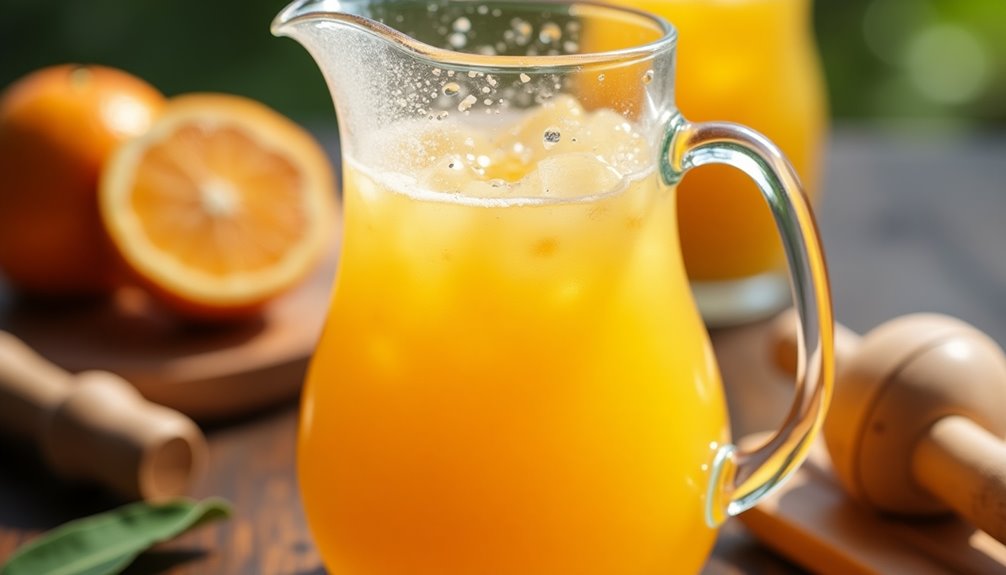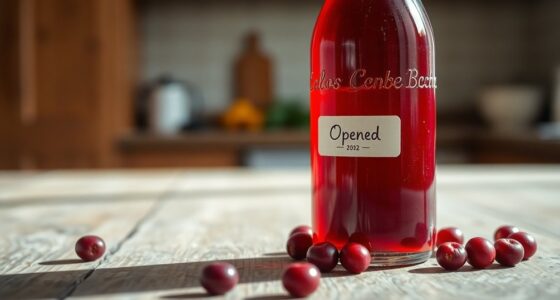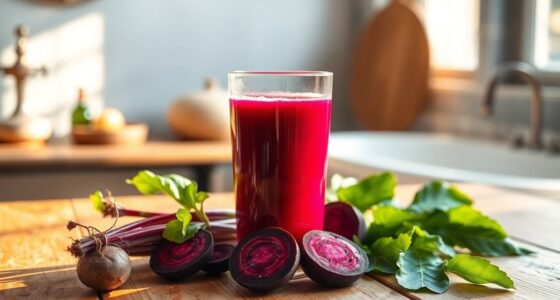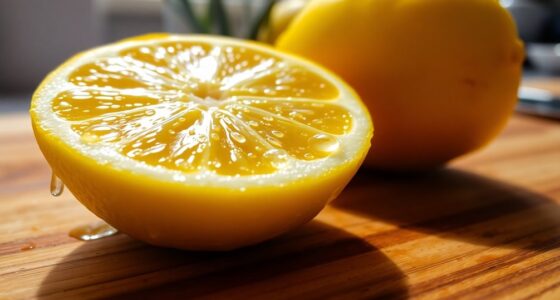You can keep fresh orange juice for 2 to 3 days in the fridge, but it spoils quickly if left out. Store-bought orange juice lasts 1 to 2 weeks when unopened, and once opened, you should drink it within 7 to 10 days. Shelf-stable juice can sit unopened for 3 to 9 months. Always check for off smells or color changes to ensure freshness. To find out more about proper storage and spoilage signs, keep exploring!
Key Takeaways
- Fresh orange juice should be consumed within 2 to 3 days when refrigerated for optimal taste and nutritional value.
- Store-bought orange juice lasts 1 to 2 weeks unopened and 7 to 10 days after opening when refrigerated.
- Shelf-stable orange juice can last 3 to 9 months unopened; consume within 8 to 10 days after opening for best flavor.
- Always refrigerate orange juice to prolong freshness and avoid leaving it at room temperature for more than 2 hours.
- Regularly check for signs of spoilage, such as off smells or changes in color, to ensure safety.

When you enjoy a glass of orange juice, you might wonder how long it stays fresh. Fresh orange juice, especially when squeezed at home, is a delightful treat loaded with vitamin C and flavor. However, to maintain its freshness and nutritional quality, it's best to consume it within 2 to 3 days when refrigerated. After this period, the juice can lose its vibrant taste and beneficial properties, making it less enjoyable and nutritious.
On the other hand, if you prefer the convenience of store-bought orange juice, you'll find that it has a different shelf life. Unopened, refrigerated commercial orange juice can last anywhere from 1 to 2 weeks. Once you crack open that carton, though, it should ideally be consumed within 7 to 10 days. This is because the moment you open the juice, exposure to air and bacteria increases the likelihood of spoilage. It's essential to keep it properly stored in the refrigerator to slow down this process.
When it comes to shelf-stable orange juice, the longevity is even more impressive. Unopened, it can last anywhere from 3 to 9 months, depending on the packaging. This makes it a great option for those who want to stock up. However, once you open it, the clock starts ticking. You'll want to refrigerate it and consume the juice within 8 to 10 days for the best taste.
One critical point to remember is that fresh orange juice spoils quickly when left at room temperature. It's essential not to let it sit out for more than 2 hours. If you do, you risk significant bacteria growth that could lead to foodborne illnesses. So, if you pour yourself a glass and don't finish it, it's wise to pop it back in the fridge promptly.
Understanding spoilage is crucial when enjoying any type of orange juice. Fresh orange juice, while tasty and nutritious, has a much shorter shelf life compared to its store-bought counterparts. If you're ever in doubt about whether your juice is still good to drink, check for any off smells or changes in color. Trust your senses; they can often tell you more than the expiration date on the carton.
Frequently Asked Questions
How Long Will Orange Juice Last in the Refrigerator?
When you store orange juice in the refrigerator, its longevity varies.
Freshly squeezed juice typically lasts about 2 to 3 days.
If you've opened a commercially produced carton, it can stay good for 7 to 10 days, depending on its type.
Unopened refrigerated juice usually remains fresh for 1 to 2 weeks past its expiration date.
Always keep it in airtight containers and at temperatures between 32 to 40 degrees Fahrenheit to maximize freshness.
How Can You Tell if Orange Juice Has Gone Bad?
When you pop open a bottle of orange juice, you expect a burst of freshness, not a whiff of vinegar.
To tell if your juice has gone bad, trust your senses. If it smells off or looks moldy, it's time to toss it.
Notice any unusual color changes or lumps? That's a red flag too.
Always check the expiration date—better safe than sorry when it comes to your morning OJ!
Is Orange Juice Good After 2 Weeks?
You shouldn't consume orange juice after 2 weeks, especially if it's been opened.
By this time, the quality likely deteriorates, and you might encounter health risks due to bacterial growth. Always check for signs of spoilage, like off smells or mold, before drinking.
If you've stored it properly, unopened juice might still be okay for a bit longer, but once it's open, aim to finish it within a week for safety.
Can You Drink Orange Juice 7 Days After Opening?
Yes, you can drink orange juice 7 days after opening, but it's crucial to check for freshness first.
Look for any off-smells, changes in color, or signs of mold. If it smells fresh, looks vibrant, and tastes good, you're likely in the clear.
Just remember to keep it tightly sealed and refrigerated during those days to maintain its quality.
Trust your senses, and you'll enjoy your juice safely!
Conclusion
In the end, keeping orange juice is a bit like holding onto a summer memory—too long, and it loses its zest. If you've ever taken a sip of juice that's past its prime, you know how quickly freshness fades. Just like that vibrant summer day, enjoy your orange juice within a week after opening for the best flavor. So, savor it while it lasts, and let each sip remind you to cherish the fleeting moments in life.
Cindy thoroughly researches juicing trends, techniques, and recipes to provide readers with practical advice and inspiration. Her writing style is accessible, engaging, and designed to make complex concepts easy to understand. Cindy’s dedication to promoting the advantages of juicing shines through her work, empowering readers to make positive changes in their lives through the simple act of juicing.
















